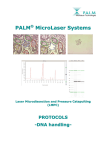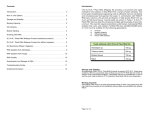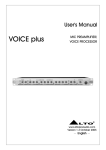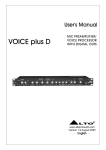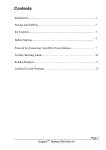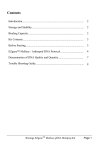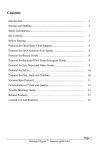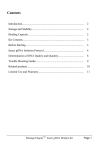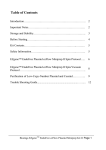Download Contents - Biomiga
Transcript
Contents Introduction........................................................................................ 2 Storage and Stability……………………………………………… 2 Kit Contents........................................................................................ 2 Before Starting……………………………………………………… 3 Avoid Rnase Contamination……………………………………….. 4 Polyacrylamide Gel Recovery Protocol…………………………… 5 Page 1 EZgene TM Poly-Gel RNA Purification Kit Introduction The EZgene™ Poly-Gel RNA Recovery Kit provides an easy and reliable method for recovering RNA probes from denaturing acrylamide gels. The probe is eluted by passive diffusion from the gel fragment with a unique buffer system and further purified using an ezBind RNA spin-column. The procedure can produce enough probes, ready for hybridization in 1-4 hours. The eluted RNA is ultra clean and ready for subsequent analysis and molecular manipulation. Storage and Stability All components of the Poly-Gel RNA Recovery Kit are stable for at least 24 months from the date of purchase when stored at 22-25oC. Once diluted, RNA Wash Buffer Concentrate must not be refrigerated. Kit Contents Catalog# RC361200 RC3612-01 Preps 4 50 250 RNA columns 4 50 250 Filter Units 4 50 250 Collection Tubes 8 100 500 Buffer CS 2 mL 20 mL 100 mL Buffer LY 4 mL 50 mL 250 mL RNA Wash Buffer 4 mL 24 mL 80 mL DEPC-treated H2O 1.2 mL 20 mL 100 mL 1 1 1 User Manual Page 2 TM EZgene Poly-Gel RNA Purification Kit RC3612-02 Before Starting Prepare all components and get all necessary materials ready by examining this instruction booklet and become familiar with each steps. Important Add 16 mL (RC3612-00) or 96 mL (RC3612-01) or 320 mL (RC361202) 96%-100% ethanol to RNA Wash Buffer before use. Buffer *** may form crystals under cool ambient conditions. It is critical to warm up the buffers at 37oC to redissolve the salt. Add 20 µL of β-mercaptoethanol (β-mercaptoethanol) per 1 mL of Buffer RB before use. This mixture can be stored at room temperature up to 1 month. All centrifugation steps must be carried out at room temperature. Materials supplied by users 96%-100% ethanol Micro-centrifuge capable of 10,000 x g RNase-free microcentrifuge tubes and tips Disposable latex gloves Page 3 EZgene TM Poly-Gel RNA Purification Kit Avoiding RNase Contamination Please prepare materials as following instructions when working with RNA. 1. For RNA use only: Keep a separate set of pipettors for RNA use to avoid contamination with RNases. Avoid touching the barrel or metal ejector to the sides of tubes. 2. Solutions: Store solutions in small aliquots and discard each aliquot after use. 3. Electrophoresis apparatus: Wash with detergent solution, rinse in H2O, and dry with ethanol. Then fill with 3% solution of H2O2 (Don't use DEPC solutions because it will break down the plastic), incubate 10 mins at room temperature and rinse with DEPC treated H2O. 4. Glassware: Bake glassware at 300°C for 4 hours or 180°C or higher for several hours. Alternatively, soak glassware in freshly prepared 0.1% (v/v) DEPC in water or ethanol for 1 hour, drain, and autoclave (I t is necessary to destroy any unreacted DEPC which can otherwise react with other proteins and RNA). 5. Plasticware: Treat plasticware with DEPC. Use RNase-free disposable tips and tubes. Use sterile forceps to transfer items to racks. 6. Gloves: Use gloves from a fresh box at all times. Don't touch the gloves to any surface that might be contaminated with RNases. 7. Work carefully and quickly during the procedure. Page 4 TM EZgene Poly-Gel RNA Purification Kit Polyacrylamide Gel Recovery Protocol I. RNA Probe Elution and Purification 1. Remove the gel from the plastic wrap and place in a 2.0 µg/mL acridine orange solution for 15 minutes. Destain the gel in distilled water for 10 minutes. Re-wrap the gel in plastic wrap for easier handling, and place the gel on a UV transilluminator to visualize the probe. Note: Either acridine orange or EtBr may be used for staining. 2. Carefully cut the smallest gel fragment which contains the probe with RNase-free razor blade. Note: Cut the gel corresponds to bright purple band on the TLC plate or band in the gel. The smaller the size of this gel fragment, the better the elution efficiency. This band should be the most intense band present. If you are concerned that not all the probe was cut out, visualize the gel again with UV light to verify that the probe band is gone. 3. Transfer the gel fragment onto a nuclease-free microscope slide. Mash and pulp the gel completely with a second glass slide (or nuclease-free razor). Carefully transfer gel pulp to a nuclease-free microcentrifuge tube and add 200 µL Buffer PGC (A slice of 2 mm x 5 mm x 0.75 mm corresponds to 200 µL). Note: For a larger fragment increase the volume of Buffer PG until the gel is covered. 4. Incubate the tube at 65 oC for 1-2 h. Note: The elution time depends on the size of the gel fragment, RNA Page 5 EZgene TM Poly-Gel RNA Purification Kit size and the temperature of the incubation. About 90% of a 400 nt transcript could be eluted in 1 hr at 65°C. Larger fragments will take longer to elute. Proceed to step 3 for RNA clean up if downstream applications involve enzymatic manipulation. Note: It is not necessary to elute all the probe prior to hybridization, only what will be needed (i.e. 5-10 x 104 cpm of a high specific activity probe per RNASE-protection assay reaction, or 1x 107 cpm for Northern Assays). An aliquot of Buffer PGC (containing some of the probe) can be removed at any time during the elution and used directly in the hybridization reaction. This allows setup of hybridization reactions on the same day as probe preparation. Note that elution of a high specific activity probe in 200 µL of elution buffer should yield approximately 2-5 x 104 cpm/µL. II. RNA Probe Clean Up All subsequent steps are required only if downstream application involve enzymatic reactions, such as reverse-transcription. Carry out these steps carefully but quickly. Probes>250 nt 5. Transfer gel and buffer to a Poly-Gel filter unit mounted in a sterile 1.5 mL microcentrifuge tube. Use a blue pipette tip with the end cut to do this. Centrifuge at 10,000 x g for 5 min at room temperature to filter the sample. 6. To the eluate add 800 µL Buffer RB/β-mercaptoethanol (β-ME) and vortex briefly to mix.With radioisotopic probes also add 5 µg yeast tRNA in no more than 25 µL as carrier. Add 600 µL absolute ethanol and immediately vortex for 1 min. A precipitate may form on addition Page 6 TM EZgene Poly-Gel RNA Purification Kit of ethanol. This will not interfere with the procedure and should be thoroughly resuspended. Proceed to the next step without delay. Note: Remember to add 20 µL 2-mercaptoethanol per 1 mL of Buffer RB before use. This mixture is stable at room temperature for 1 week. 7. Apply 700 µL of sample from previous step onto ezBind RNA spin column (Red) assembled in a 2 mL collection tube (supplied). Centrifuge 20 seconds at 10,000 x g (approx 12,500 rpm on most micro-centrifuges). 8. Discard flow-through liquid from previous step. Apply the remaining sample and centrifuge as above. Again discard flow -through liquid and reuse 2 mL collecting tube in next step. 9. Wash the column by adding 700 µl RNA Wash Buffer (Add absolute ethanol before use). Centrifuge as above. Discard liquid and 2 m L collecting tube. 10. Place column into a New 2 mL collection tube. Pipet 500 µl RNA Wash Buffer onto spin column. Centrifuge as above and discard flowthrough and re-use the collection tube in next step. Place the column into the same collection tube from previous step. Spin empty column 2 m in at 10,000 x g to dry ezBind matrix. This is critical for removing residual ethanol which m ay otherwise be carried over during elution and interfere with downstream applications. 11. Transfer spin column to a new 1.5 m L microfugetube. Elute the probe by pipetting 100 µl DEPC -treated water (supplied) directly onto m atrix. Centrifuge 1 minute at 8,000 x g (approx 10,000 rpm on most micro-centrifuges). For non-isotopic probes (usually present in microgram quantities) repeat the elution with a second 100 µl aliquot of Page 7 EZgene TM Poly-Gel RNA Purification Kit DEPC -water to improve yield. Probes < 250 nt An optional phenol:chloroform extraction followed by precipitation with ethanol is suggested for RNA molecules <250 nt. For ethanol precipitation, add ammonium acetate to a final concentration of 0.5 M and add 2.5 x volice cold ethanol. Radioisotopic probes may also require 10 µg of yeast tRNA as carrier. Non-isotopic probes will usually not need carrier as higher amounts are eluted from the gel. Note that phenol extractions should not be performed with digoxigenin-labeled probes since RNA will separate into the organic phase. III. Probe Quantitation Radioisotopic Probes Analyze the eluted probe by scintillation counting to determine the concentration (cpm/mL). A typical transcription reaction should yield approximately 2-6 x 104 cpm/µl in 100 µl. Probe should be stored at -20 oC or -70 oC for greater stability. Non-isotopic Probes Measure the OD readings at 260 and 280 nm .The 260/280 ratio should be 1.9-2.0. Low 260/280 ratios indicate protein/acrylam idecontamination which can lead to inaccurate concentration calculations. Based on OD260 reading and the conversion: 1 A260 unit = 40 µg RNA, calculate the concentration of the probe. A typical 20 µL transcription reaction (containing 0.5 m M of each NT P) and subsequent gel purification should yield about 4-8 µg of R N A. The probe should be stored at -20 oC or -70 oC for greater stability. Degradation typically starts after 5-10 freeze-thaw cycles, so the probe should be stored as aliquots Page 8 TM EZgene Poly-Gel RNA Purification Kit









